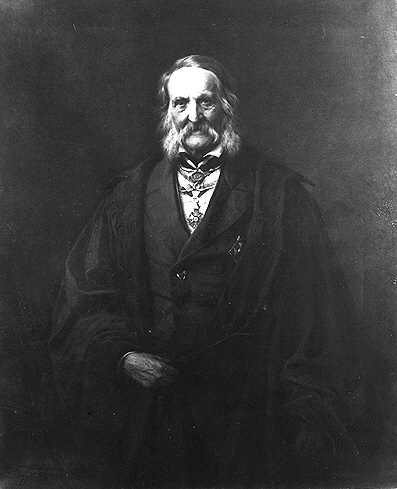- Franz Ernst Neumann
Infobox_Scientist
name = Franz Ernst Neumann
 |300px
|300px
image_width = 300px
caption = Franz Ernst Neumann
birth_date = birth date|1798|9|11|df=y
birth_place = Joachimsthal,Germany
death_date = death date and age|1895|5|23|1798|9|11|df=y
death_place =Königsberg ,Germany
residence =Germany
nationality = German
field =Physicist ,Mineralogist
work_institution =Königsberg University
alma_mater =University of Berlin
doctoral_advisor =Christian Samuel Weiss
doctoral_students =Woldemar Voigt , Philipp Wilhelm Brix,Alfred Clebsch , E. F. J. Theodor Abel, Oskar Frölich, Friedrich Gustav Adolph Just, Oscar Emil Meyer, Gottlieb Anton Müttrich, Louis Saalschütz, A. Emil Schinz, Karl Von der Muehll,Gustav Robert Kirchhoff ,Friedrich Heinrich Albert Wangerin
known_for =Neumann's law
prizes =
religion =
footnotes =Franz Ernst Neumann (
September 11 ,1798 -May 23 ,1895 ) was a Germanmineralogist ,physicist andmathematician .Life
Neumann was born in Joachimsthal,
Margraviate of Brandenburg , located not far fromBerlin . In 1815 he interrupted his studies at Berlin to serve as a volunteer in theHundred Days againstNapoleon , and was wounded in theBattle of Ligny . Subsequently he enteredBerlin University as a student oftheology , but soon turned to scientific subjects. His earlier papers were mostly concerned withcrystallography , and the reputation they gained him led to his appointment asPrivatdozent at theUniversity of Königsberg , where in 1828 he became extraordinary, and in 1829 ordinary, professor ofmineralogy andphysics . His 1831 study on thespecific heat s of compounds included what is now known asNeumann's law : the molecular heat of a compound is equal to the sum of the atomic heats of its constituents.Devoting himself next to optics, he produced memoirs which entitle him to a high place among the early searchers after a true dynamical theory of light. In 1832, by the aid of a particular hypothesis as to the constitution of the ether, he reached by a rigorous dynamical calculation results agreeing with those obtained by
Augustin Louis Cauchy , and succeeded in deducing laws of double refraction closely resembling those ofAugustin-Jean Fresnel . Later he attacked the problem of giving mathematical expression to the conditions holding for a surface separating two crystalline media, and worked out from theory the laws of double refraction in strained crystalline bodies. He also made important contributions to the mathematical theory of electrodynamics, and in papers published in 1845 and 1847 established mathematically the laws of the induction of electric currents. His last publication, which appeared in 1878, was on spherical harmonics ("Beitrage zur Theorie der Kugelfunctionen").With the mathematician
Carl Gustav Jacobi , he founded in 1834 the "mathematisch-physikalisches" seminar which operated in two sections, one for mathematics and one for mathematical physics. Not every student took both sections. In his section on mathematical physics Neumann taught mathematical methods and as well as the techniques of an exact experimental physics grounded in the type of precision measurement perfected by his astronomer colleagueFriedrich Wilhelm Bessel . The objective of his seminar exercises was to perfect one's ability to practice an exact experimental physics through the control of both constant and random experimental errors. Only a few students actually produced original research in the seminar; a notable exception was Gustav Robert Kirchoff who formulatedKirchhoff's Laws on the basis of his seminar research. His seminar was the model for many others of the same type established after 1834, including that ofGustav Robert Kirchhoff atHeidelberg University .Neumann retired from his professorship in 1876, and died at
Königsberg (nowKaliningrad ,Russia ) in 1895 at the age of 96.His children were talented. His son,
Carl Gottfried Neumann (1832-1925), became in 1858 Privatdozent, and in 1863 extraordinary professor of mathematics at Halle. He was then appointed to the ordinary chair of mathematics successively atBasel (1863),Tübingen (1865) andLeipzig (1868).Works by F. E. Neumann
* [http://books.google.com/books?id=eN4KAAAAIAAJ&pg=PA1&dq=%22Franz+Ernst+Neumann%22&as_brr=1&hl=en#PPR1,M1 Beiträge zur Krystallonomie] (Mittler, Berlin, 1823)
* [http://gallica.bnf.fr/notice?N=FRBNF37258606 Beiträge zur Theorie der Kugelfunctionen] (B. G. Teubner, Leipzig, 1878)
* [http://quod.lib.umich.edu/cgi/t/text/text-idx?c=umhistmath&idno=AAN8146 Franz Neumanns Gesammelte werke (2 vols.)] (B. C. Teubner, Leipzig, 1906-1928)References
*1911
* Olesko, Kathryn M. "Physics as a Calling: Discipline and Practice in the Koenigsberg Seminar for Physics". Ithaca, NY & London: Cornell University Press, 1991.ee also
*
Neumann line External references
*
*
* [http://libserv.aip.org:81/ipac20/ipac.jsp?uri=full=3100001~!667~!0&profile=newcustom-icos Primary sources on Neumann]Persondata
NAME= Neumann, Franz Ernst
ALTERNATIVE NAMES=
SHORT DESCRIPTION= GermanPhysicist ,Mineralogist
DATE OF BIRTH=11 September 1798
PLACE OF BIRTH= Joachimsthal,Germany
DATE OF DEATH=23 May 1893
PLACE OF DEATH=Königsberg ,Germany
Wikimedia Foundation. 2010.
